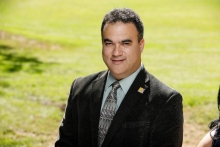CBE & MSE Seminar: The Convergence of Light with Materials: Towards the Development of Novel Biomedical Applications

Department of Mechanical Engineering
University of California, Riverside
Abstract: Aguilar founded the Laboratory of Transport Phenomena for Biomedical Applications (LTPBA) at UC Riverside after starting his tenure-track position in 2003.Initially, his group carried out studies aimed at understanding how lasers interact with biological tissue and how combined cooling and heating processes could improve diagnostics and therapeutics in dermatology. For example, they provided a better understanding of how cryogenic sprays could be used effectively to cool the skin during dermatologic laser therapy. Then, they looked at feasible ways to improve transdermal drug delivery by taking advantage of the thermal and mechanical property changes of tissue induced by cryogen liquid deposition on the skin surface. Later, another set of studies was aimed at using CW laser radiation to generate multiple vapor bubbles within a thin liquid layer, and to use the shockwaves these bubbles emit upon their collapse, to perforate skin for enhanced drug delivery. At a more fundamental level, the lab recently showed that researchers can measure the temperature field around a cavitation bubble non-intrusively, using a pulsed-laser induced fluorescence (PLIF) technique. Currently, the main research thrust in Aguilar's group aims at developing a novel transparent polycrystalline Yttria-Stablized-Zirconia (YSZ) cranial implant (“window”) that enables life-long, non-invasive delivery and/or collection of laser light into and from shallow- and deep-brain tissue on demand. Such an implant would allow for real-time and highly precise visualization and treatment of diverse brain pathologies, such as those resulting from traumatic brain injury (TBI) or brain tumors, without the need for highly invasive craniotomies or trepanation procedures. Various projects involving in vitro, in vivo, and fundamental research have yielded interesting results in connection with this “window”. Most of them involve various students working together across disciplinary boundaries. A summary of the lab's approach, latest results, and ongoing and future studies will be presented during Aguilar's talk.
Bio: Guillermo Aguilar received his B.S. in mechanical and electrical engineering from the National Autonomous University of Mexico (UNAM) in 1993. He earned his M.S. and Ph.D. also in mechanical engineering at UC Santa Barbara in 1995 and 1999, respectively. In 1999, he received a Whitaker Postdoctoral Fellowship to join the Beckman Laser Institute and the former Department of Chemical and Biochemical Engineering and Material Sciences at UC Irvine. In 2001 he was appointed as an assistant adjunct professor a tUCI's Center for Biomedical Engineering.
In 2003, Aguilar joined the Department of Mechanical Engineering at UC Riverside, where he was promoted to associate professor in 2007 and full professor in 2012. Since 2013, has served as the department chair. Aguilar has co-authored more than 90 journal publications, advised more than 12 postdocs, 50 students, including 25 graduate students (MS and PhD) and several undergraduate students and interns.
Aguilar has received research funding from various sources, including NSF, ASLMS, AFOSR, Sandia National Labs, NIH, etc. His current research interests include cryogen spray cooling, laser-tissue interactions, biomedical optics and medical lasers.
Host: James Earthman
Share
Upcoming Events
-
MSE 298 Seminar: Mechano-Electrochemical Phenomena at Ceramic Electrolyte Interfaces
-
MSE 298 Seminar: Innovation In Materials Science - An Industrial R&D Perspective
-
MSE 298 Seminar: Understanding the Impact of Grain Boundary Inclination on Grain Growth Using Modeling and Simulation and Experiments
-
EECS Seminar: Mixed Conductors for Bioelectronics
-
MSE 298 Seminar: Ionic Correlations in Polymer Nanostructures - From Block Copolymers to End-Charged Blends
